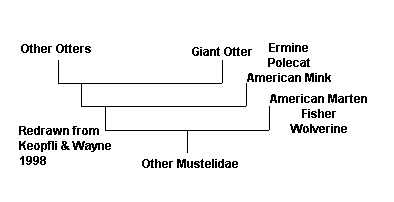Classification of the Giant Otter
Historical Confusion
The classification of the South American Giant Otter was very confused for a long time. The following is a summary of the account of this in Harris (1968).The animal was probably first described by Marcgrave (1648) - unless he had confused it with the Tayra, Eira barbara. In 1758, Linnaeus amalgamated the Giant Otter and the Sea Otter (Enhydris lutra>) because they were the same size. Very few of the naturalists describing the animal had ever seen it, whereas the Sea Otter was relatively well known. Zimmerman (1777) found this unlikely, but confusion continued for some time.
Following Buffon (1787), the animals were known by francophone writers such as Desmarest as Sarcoviennes (and the genus Saricovia).
The name Pteronura appeared in 1837, coined by Gray (1837), who saw the genus as intermediate between Lutra and Enhydra. Some contemporary writers thought of Pteronura and Saricovia as separarate animals, the latter being the Giant Otter, and the former being identical but the size of the Eurasian Otter.
Other systematic names for the animal included Lutra lupina, Lutra brasiliensis, Mustela lutris brasiliensis, Lutra sambachii, Lontra brasiensis, Lutra paraguaensis, Lutra paranensis and Lutra paroensis. As late as 1978, Davis (1978)classified them as part of the Aonychini tribe, along with Aonyx, Enhydra and Lutrogale, based on the baseball-bat-like shape of the baculum.
Even more confused was the relationship between the Giant Otter and other otters. For the last few decades, people have been speculating as to whether the Giant Otter was actually unrelated to other otters, and an example of convergent evolution.
Modern Taxonomy
The animal is now known as Pteronura brasiliensis, the name originally proposed by Gmelin in 1788 (Harris (1988)).For a long time, two subspecies were recognised: Pteronura brasiliensis brasiliensis, living in the Amazon basin and northwards, and Pteronura brasiliensis paranensis, living in the River Uruguay and Paraguay systems. This differed from the other subspecies in having a slightly broader skull and only 4 molariform teeth in each side of the upper jaw instead of 5. Many writers now, including Duplaix (1980), do not consider these as true subspecies, given the amount of variation in skull size and shape, and variable dentition in the animals observed in Suriname and Peru.
 The relationship between Pteronura and other otter lineages has now been elucidated using DNA analysis by Koepfli & Wayne(1998). It seems clear that when the ancestral otters diverged from the rest of the Mustelidae, the first group to split off and specialize was Pteronura - they are therefore their own "tribe" compared to the Lutra and Lontra otters.
The relationship between Pteronura and other otter lineages has now been elucidated using DNA analysis by Koepfli & Wayne(1998). It seems clear that when the ancestral otters diverged from the rest of the Mustelidae, the first group to split off and specialize was Pteronura - they are therefore their own "tribe" compared to the Lutra and Lontra otters.
The genetic code for the Giant Otter can be found by searching for Pteronura brasiliensis at the National Center for Biotechnology Information.
Other Names for the Giant Otter
Local Names: Ariranha, Arirai, Saro.
Spanish: Lobo corbate ("cravatted wolf"), Lobo gargantilla, Lobo del Rios ("River Wolf"),Lobito de Cola Ancha, Nutria gigante, Perro de Agua.
English: South American Giant Otter, Brazilian Otter, Guiana Flat-Tailed Otter, Winged-Tailed Otter, Margin-Tailed Otter, Brazilian Giant Otter.
German: Riesenotter.
French: Loutre geante du Brasil.
Italian: Lontra gigante del Brasile.
| Giant Otter |

